Sapphire Radeon R9 290 Tri-X OC Review: Our First Custom Cooled 290
by Ryan Smith on December 24, 2013 3:45 PM EST- Posted in
- GPUs
- AMD
- Radeon
- Sapphire
- Radeon 200
Overclocking
Our final evaluation criteria is overclocking. Since the 290 Tri-X OC is based on AMD’s reference board, the card has the same overclocking functionality and capabilities as any reference card. Which is to say that we have voltage control and monitoring, but the board itself is not particularly engineered for extreme overclocking. At the same time the nature of putting together a card like the 290 Tri-X OC means that Sapphire is doing some degree of binning,
| Radeon R9 290 Overclocking | ||||
| Sapphire Radeon R9 290 Tri-X OC | Ref. Radeon R9 290 | |||
| Shipping Core Clock | 699MHz | 662MHz | ||
| Shipping Boost Clock | 1000MHz | 947MHz | ||
| Shipping Memory Clock | 5.2GHz | 5GHz | ||
| Shipping Boost Voltage | ~1.18v | ~1.18v | ||
| Overclock Core Clock | 824MHz | 790MHz | ||
| Overclock Boost Clock | 1125MHz | 1075MHz | ||
| Overclock Memory Clock | 6GHz | 5.6GHz | ||
| Overclock Max Boost Voltage | ~1.23v | ~1.18v | ||
For overclocking the 290 Tri-X OC, we increased the PowerTune limit by 20% and the voltage by 50mV to what’s roughly 1.23v. Out of this we were able to get another 125MHz (13%) out of the GPU and 800MHz (15%) out of the VRAM, now topping out at 1125MHz for the GPU boost clock, and 6GHz for the VRAM. The final clockspeeds are better than our previous efforts at overclocking our reference 290 (which was prior to voltage control), although only moderately so.
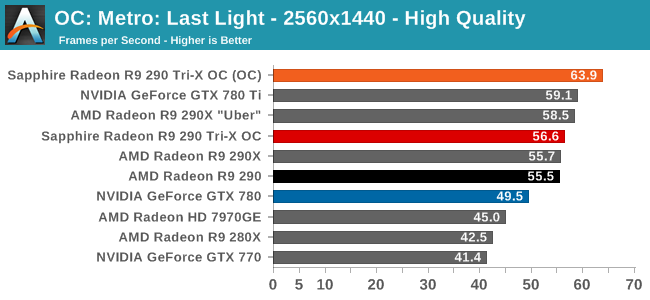
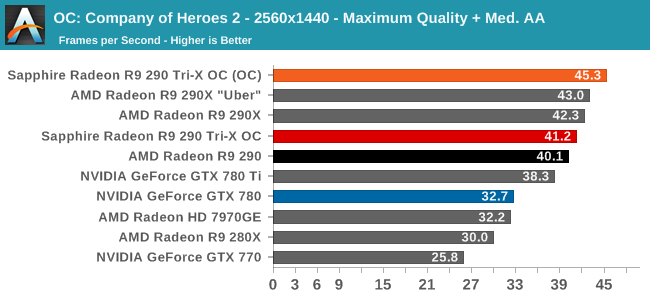
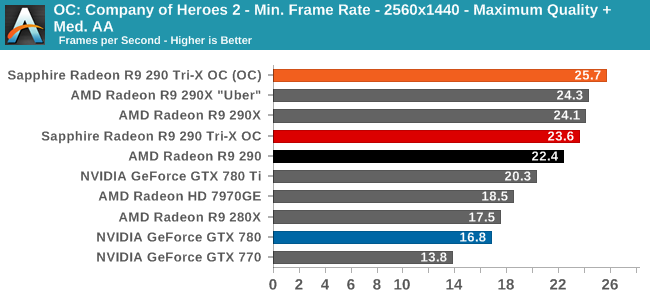
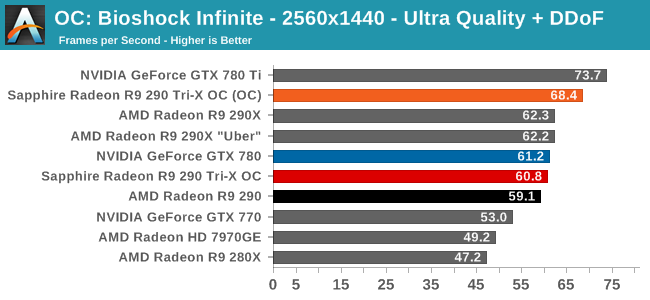
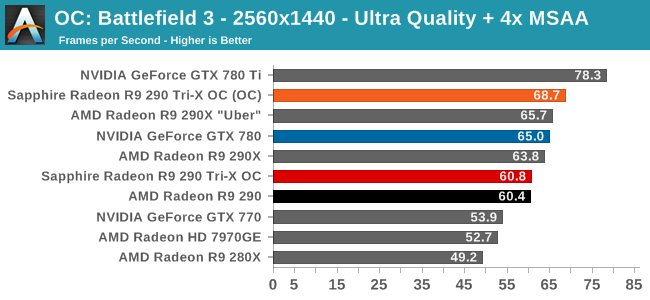
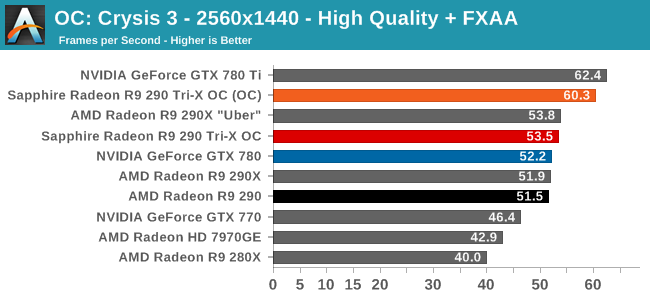
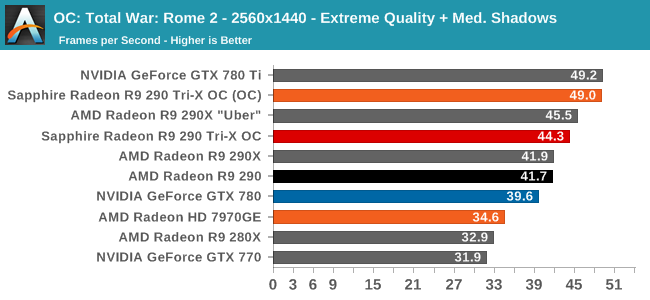
Starting first with gaming performance, as a more extensive overclock relative to Sapphire’s factory overclock, the performance gains from our own overclocking have yielded very solid results, despite the fact that this isn’t explicitly an overclocking board. Between the 13% core overclock and 15% memory overclock, the average performance increase measures in at 12%, varying depending on whether a game is more bandwidth limited, GPU limited, or CPU limited.
At 12% faster the overclocked 290 Tri-X OC is fast enough to largely close the gap between it and the reference GeForce GTX 780 Ti. Otherwise it will consistently outscore the 290X in “uber” mode, even in spite of the pared down nature of the Hawaii GPUs used in 290 cards.
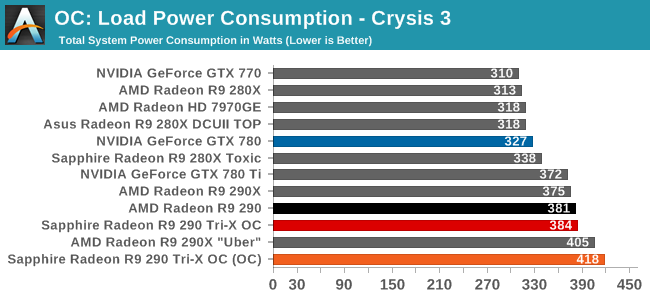
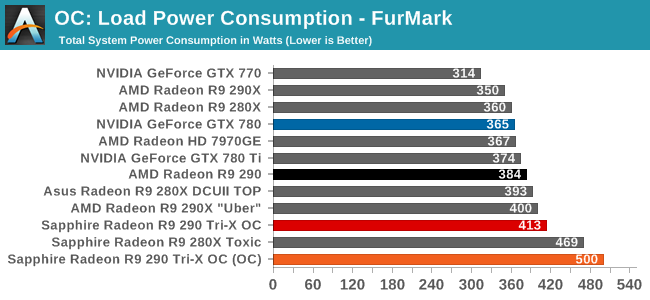
The power consumption penalty for overclocking is significant, but outside of the outright power limited FurMark, is not unreasonable. Under Crysis 3 the additional 13% in performance comes at a cost of 30W at the wall, most of which will be from the video card.
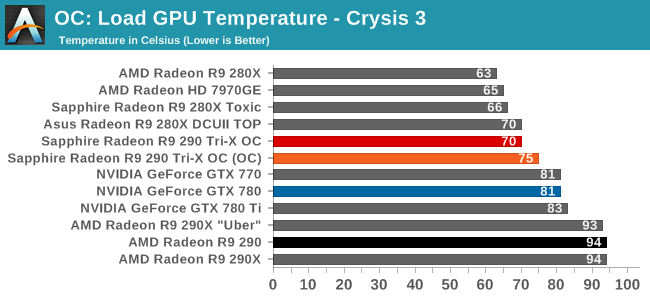

Along with power consumption overclocking also comes with the expected increase in operating temperatures. Under Crysis 3 this is an increase of 5C to 75C, while for FurMark (where the increase in power was greater) this is an additional 7C to 81C. FurMark definitely gives the Tri-X cooler a harder time when the video card is overclocked, but as this is a worst case scenario it also means that operating temperatures should still remain well under 80C, as evidenced by Crysis 3.

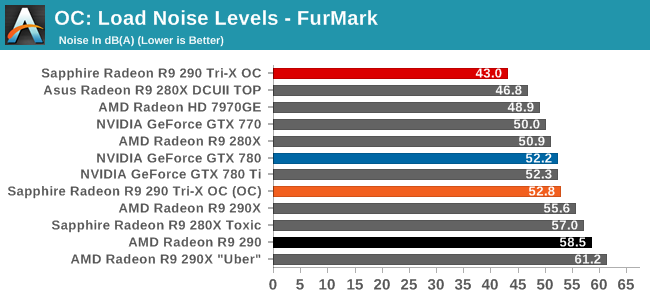
Even with our overclocking the 290 Tri-X OC still holds up rather well when it comes to Crysis 3. At 45.6dB this is a 4.5dB increase in noise, more than enough to be noticed, but notably it’s still quieter than our stock 280X and 7970GE, both of which are similarly open air coolers. FurMark on the other hand pushes the card much harder since it’s reaching the new 120% PowerTime power limit, leading to a jump in noise of just under 10dB to 52.8dB. Even faced with an overclocked FurMark the Tri-X cooler is still holding up very well, though we’ve clearly reached the point (with regards to thermal loads) where it has lost its near-silence.










119 Comments
View All Comments
Godigy - Wednesday, December 25, 2013 - link
No, it follows the reference design, but Sapphire decided to put different chokes on. You'll see that Sapphire put on CEC R15 chokes, and the reference cards uses different chokes from the same brand.sparkuss - Wednesday, December 25, 2013 - link
Looking at the picture they appear to be the same size though, don't they? Only a change in size or orientation should give a problem with water-blocks, I hope.ggathagan - Monday, December 30, 2013 - link
What's the point of buying a pricier GPU with a custom cooler if you intend on replacing the cooler with water blocks?sparkuss - Monday, December 30, 2013 - link
Basically because every time I think I'm ready to build my watercool rig, something happens and I don't follow through. But I still want to upgrade the GPU and I end up waiting too long before the reference cards are all gone. With this remaining reference I get all the benefit of the better cooling and can still hang on to it until I WC.shotgunx1x - Tuesday, December 24, 2013 - link
I know it should be soon, but any idea when we can expect these to be available?Shreddie - Tuesday, December 24, 2013 - link
Most likely Mid-Late January (that's the estimated DCII release date)Ryan Smith - Tuesday, December 24, 2013 - link
Sapphire says it should start hitting shelves at the end of this week.Mopar63 - Wednesday, December 25, 2013 - link
They seem to already be out with some etailers in Europe.Will Robinson - Wednesday, December 25, 2013 - link
Guess Blackened23 and Balla are just gonna ignore the beating the 780 gets in this review lololWhat was that about 780 overclocking again? :)
Mondozai - Wednesday, December 25, 2013 - link
The OC performance here is better than the review in Hexus.Also, you can get from mid-800s to mid-1200s in mhz on a custom-cooled GTX 780 with OC. The OC here is a lesser amount. I wonder what the performance would be on a maxed out-OC'd GTX 780 would be vs the OC that Ryan applied.